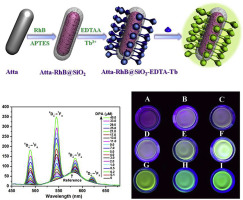Dyes and Pigments ( IF 4.5 ) Pub Date : 2017-09-05 , DOI: 10.1016/j.dyepig.2017.09.006 Jun Xu , Xiaoke Shen , Lei Jia , Chuanxiang Zhang , Tieliang Ma , Tao Zhou , Taofeng Zhu , Zhouqing Xu , Jianliang Cao , Baozhong Liu , Ning Bi , Lianqi Liu , Yizhe Li

|
Since the 2001 anthrax attacks, researchers have focused on the development of a bacterial spore biomarker detector with rapid response time and high sensitivity and selectivity. Hence, a ratiometric fluorescent nanosensor based on lanthanide-functionalized attapulgite (Atta) was designed and prepared using dye-doped Atta as an internal reference. Atta, which is famous because of Maya Blue, is a hydrated magnesium aluminum silicate present in nature, with pronounced adsorption and a large specific surface area rich in silicon hydroxyl. The adsorption of dye molecules benefits the formation of an internal reference with orange fluorescence. Meanwhile, silicon hydroxyl would be available for terbium (Tb3+) complex grafting, which favors the sensitization of the bacterial spore biomarker. With increasing dipicolinic acid (DPA) concentrations, energy transfer from DPA to Tb3+ gradually enhanced, thereby resulting in strong and predominant green fluorescence. The ratiometric fluorescence intensity is highly sensitive. It has a limit of detection of 9.8 nM, which is much lower than the infectious dosage of Bacillus anthracis spores (60 μM) for humans. The rapid response time (10s), high selectivity, and reliable and practical performances in actual applications make this ratiometric fluorescent nanosensor useful in the detection of biomarkers for various bacterial spores. Moreover, the reported construction of visual ratiometric detection system follows the sustainable development idea of ‘‘from nature, for nature, into the nature’’ and promotes the use of naturally renewable resources to produce promising and eco-friendly functional materials for various applications.
中文翻译:

一种基于镧系元素的凹凸棒石纳米粒子的比例纳米传感器,用于细菌孢子生物标记物的快速灵敏检测
自2001年炭疽热袭击以来,研究人员一直致力于开发具有快速响应时间,高灵敏度和选择性的细菌孢子生物标志物检测器。因此,设计并基于掺杂了染料的Atta作为内部参考,设计了一种基于镧系元素官能化凹凸棒石(Atta)的比例荧光纳米传感器。由于玛雅蓝而闻名的Atta是自然界中存在的一种水合硅酸铝镁,具有明显的吸附性和比表面积,富含硅羟基。染料分子的吸附有利于形成带有橙色荧光的内部参照。同时,羟基硅可用于ter(Tb 3+)复杂的接枝,有利于细菌孢子生物标记物的敏化。随着二吡啶甲酸(DPA)浓度的增加,从DPA到Tb 3+的能量转移逐渐增强,从而产生强烈且占优势的绿色荧光。比例荧光强度是高度敏感的。它的检测极限为9.8 nM,远低于炭疽杆菌的感染剂量。人类孢子(60μM)。快速响应时间(10s),高选择性以及在实际应用中的可靠和实用的性能,使得这种比例荧光纳米传感器可用于检测各种细菌孢子的生物标记。此外,报告的视觉比例检测系统的建设遵循了“从自然到大自然,进入大自然”的可持续发展理念,并促进了对自然可再生资源的利用,以生产出有前景的,对环境友好的功能材料。



























 京公网安备 11010802027423号
京公网安备 11010802027423号